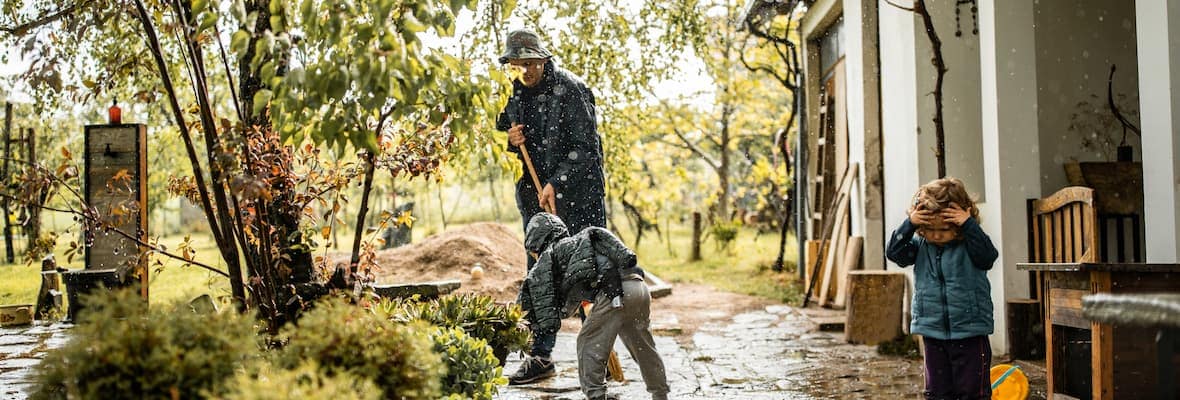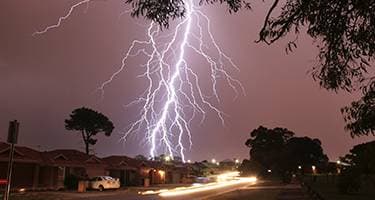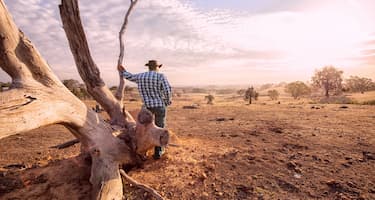Floods are one of the most damaging natural disasters in Australia, causing extensive damage to houses, businesses and agriculture.
Being caught up in a flood is serious and it's essential to have a flood safety plan to protect yourself and your loved ones should the unthinkable happen.
Our flood preparation checklist gives guidance on what to prepare before a flood, a list of what to include in your emergency kit, and the documents you should keep safe. We've also included some government links for each state and territory.
What is a flood?
At Budget Direct we define a flood as: [1]
The covering of normally dry land by water that has escaped or been released from the normal confines of the following:
- A lake, river, creek, or other natural watercourse (whether or not any of them have been altered or modified)
- A reservoir, canal, or dam
Is there a flood risk in your area?
Remember, floods don't affect every part of an area. If you live in a flood-prone area, the risk you may experience depends on the exact location of your home on your land and the height of your floor levels.
Your insurer may rely on multiple resources like the National Flood Information Database and Flood Exclusion Zones to determine the likelihood of flooding in your area. And while some areas are more prone to flooding than others you may still be at risk of flooding regardless of where you live.
Flood Zones by State
If you want to do your own research on flood zones, these resources show the potential for areas for flooding based on mapping and historical events:
- Australian Capital Territory
- New South Wales
- Northern Territory
- Queensland
- South Australia
- Tasmania
- Victoria
- Western Australia
Checking for flood-prone areas should also be a step to factor into your house-buying checklist when you start looking for a home.
What To Do Before a Flood
Floods are unpredictable and can occur at any time during the year. In Australia, you should prepare your home in case of a flood to ensure you and your family are safe.
Flood Preparation Checklist
Here's what you should do:
- Prepare a home emergency plan
- Prepare an emergency plan for pets
- Develop an evacuation plan based on your home and its surroundings
- Identify risks around your home
- Identify the safest routes and evacuation centres for shelter
- Fix faults around your home
- Purchase an emergency weather radio
- Remove leaves, debris, and other items around the home that could cause or contribute to flooding
- Store any products that contain poisons or chemicals on higher shelves to reduce potential contamination of floodwater.
Emergency Documents
Prepare a checklist of important documents including:
- A driver's licence or a military ID
- Birth certificates and citizenship documents
- Wills and Powers of Attorney
- Passports
- Marriage documents
- Adoption papers
- Family vaccine records
- Insurance policy numbers
- Property records
- A list of emergency phone numbers that you keep on display
What should be in a flood emergency kit?
Here's what you should include:
- A first-aid kit
- A torch
- Protective clothing
- Drinking water
- Portable radio with spare batteries
- Candles and waterproof matches
- Rubber gloves and waterproof bags for clothing and valuables
- A copy of your emergency plan
- A copy of your emergency contact numbers
What To Do in a Flood
During flood events, you must tune into flood warnings, execute your emergency flood response plan and evacuate your home (if it's necessary).
Adhere to Flood Warnings
Your local council or state emergency services can provide further information on how to prepare, respond and recover from flooding. They will also have local plans, warning systems, evacuation routes and flood strategies.
If a flood warning alert is issued in your area, then make sure to check the Bureau of Meteorology for further information. You can also follow them on Facebook or Twitter for regular updates on your specific region:
Execute Your Emergency Plan
After listening to flood warnings, you should start to execute your emergency flood plan:
- Locate your emergency kit
- Put fuel in your vehicle
- Pack your vehicle with emergency supplies
- Secure loose material around your house and yard
- Stack belongings onto benches and tables above the rising flood water level
- Place sandbags around your home to reduce the impact of flood damage
- Move pets and other animals to safety
- Turn off household utilities (power, gas, water)
- Check on neighbours and friends
- Stay out of floodwater and flash flooding
Evacuate If Necessary
An Australian natural disaster (such as flooding) can lead to a life-threatening emergency. In this case, you will need to evacuate.
After executing your emergency plan and filling your vehicle with fuel and emergency supplies, you should be ready to evacuate safely.
When you evacuate, you must not drive into flood water. Floodwater can hide uneven ground, discarded vehicles, debris, sewage, chemicals, deadly animals and electrical currents, which are all very dangerous.
You must stay clear of storm drains where flash flooding can occur. Flash floods near drains, pipes and grills could trap someone underwater. Heavy rainfall can also flood dams, sweep you off your feet and pin you under the water.
Return Home
After evacuating you should not return home until police or emergency services let you know the safest route to travel home. You may not return home straight away when the flooding slows down.
Here's what you should do when returning home:
- Do not enter floodwater
- Avoid travelling at night - look for road hazards such as fallen power lines, trees and debris.
- Wear protective clothing to avoid contact with contaminated surfaces and floodwater.
- Use a torch to inspect buildings
- Check for animals and wildlife that may have taken refuge in your home
- Check for damage to windows, walls and the roof
- Check if it's safe to turn on connections with electricity and gas services
- Keep all electricity, gas, and appliances turned off until a licensed electrician checks them first (if flood water has entered your home)
- Throw away any food or medications that have been in contact with floodwater
- Only drink bottled or boiled water until you can drink from the water supply safely
- Wash surfaces with antibacterial cleaner
- Take photos for any insurance company claims
Does home insurance cover flooding?
Budget Direct offers Flood Insurance as an optional cover in our Home and Contents Insurance. You can be covered for loss or damage caused by flooding to your insured address (as long as you meet our underwriting criteria).






